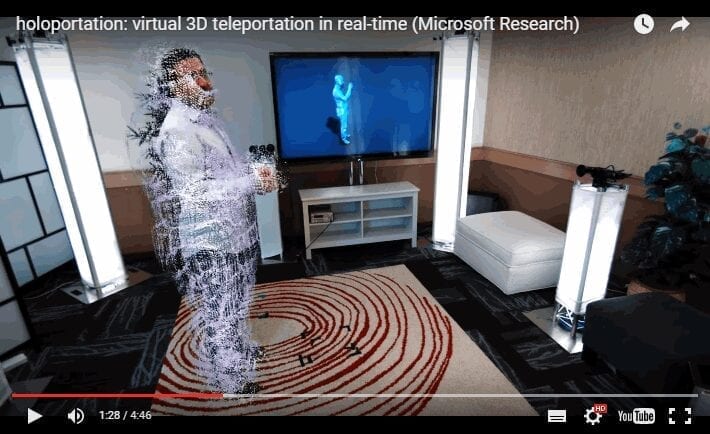
Mixed Reality (MR) and Augmented Reality (AR) create exciting opportunities to engage users in immersive experiences, resulting in natural human-computer interaction.
Many MR interactions are generated around a First-person Point of View (POV). In these cases, the user directs to the environment, which is digitally displayed either through a head-mounted display or a handheld computing device. One drawback of such conventional AR/MR platforms is that the experience is user-specific. Moreover, these platforms require the user to wear and/or hold an expensive device, which can be cumbersome and alter interaction techniques.
We create a solution for multi-user interactions in AR/MR, where a group can share the same augmented environment with any computer generated (CG) asset and interact in a shared story sequence through a third-person POV. Our approach is to instrument the environment leaving the user unburdened of any equipment, creating a seamless walk-up-and-play experience. We demonstrate this technology in a series of vignettes featuring humanoid animals.
Participants can not only see and hear these characters, they can also feel them on the bench through haptic feedback. Many of the characters also interact with users directly, either through speech or touch. In one vignette an elephant hands a participant a glowing orb. This demonstrates HCI in its simplest form: a person walks up to a computer, and the computer hands the person an object.
1 IMPLEMENTATION
We create a 3D reconstruction of a scene using a combination of the depth and color sensors on an off-the-shelf Microsoft Kinect. To do this, we draw polygons using each point in the point cloud as a vertex, creating the appearance of a solid mesh. The mesh is then aligned to the RGB camera feed of the scene from the same Kinect. This alignment gives the mesh color, and completes a 3D reconstructed video feed.
There are several problems that arise with the 3D constructed feed. First, the monocular feed creates “depth shadows” in areas where there is no direct line-of-sight to the depth sensor. Second, the depth camera is laterally offset from the RGB camera (since they cannot physically occupy the same space) and therefore have slightly different viewing angles, creating further depth shadowing. The resulting data feed is sparse and cannot represent the whole scene (see Figure 3. To solve this, we align the 3D depth feed with the 2D RGB feed from the Kinect. By compositing the depth feed over a 2D backdrop, the system effectively masks these depth shadows, creating a seamless composite that can then be populated with 3D CG assets.
This mixed reality platform centers around the simple setting of a bench. The bench works in an novel way to constrain a few problems, such as identifying where a user is and subsequently inferring the direction of the user’s gaze (i.e., toward the screen). It creates a stage with a foreground and background, with the bench occupants in the middle ground. The bench also acts as a controller; the mixed reality experience won’t trigger until at least one person is detected sitting on the bench. Further, different
seating formations on the bench trigger different experiences.
Magic Bench is a custom Software and custom Hardware platform from Disney Research, necessitating a solution to bridge both aspects. Between the two exists a series of patches created in Cycling ’74 Max designed to convert signals sent from the game engine (via OSC) about the positions and states of objects in the scene, into the haptic sensations felt on the bench. Haptic actuators are dynamically driven based on the location of animated content. The driving waveform for each actuator is designed according to the desired feel — in the current setup we can tweak base frequency, frequency of modulation, general amplitude, amplitude envelope, and three-dimensional position. These parameters can be manually tuned and/or adjusted in real time.
2 INSTALLATION OPTIONS
This piece can run as a traditional VR Village installation or as an autonomous piece in an unsuspecting area at SIGGRAPH — imagine sitting on a bench to rest your feet or check your email; in front of you is a screen showing a SIGGRAPH showreel. Once the system detects you, the content switches to a video feed of you,
creating a mirror effect. From there, an unexpected AR experience unfolds.
Learn more: Magic Bench — A Multi-User & Multi-Sensory AR/MR Platform
The Latest on: Holodeck
[google_news title=”” keyword=”holodeck” num_posts=”10″ blurb_length=”0″ show_thumb=”left”]- Hainbach: Crafting Soundscapes from Forgotten Relicson April 27, 2024 at 12:01 am
Hainbach: Crafting Soundscapes from Forgotten Relics article by Lawrence Peryer, published on April 27, 2024 at All About Jazz. Find more Radio & Podcasts articles ...
- Star Trek: 10 Characters That Faked Their Way Into Starfleeton April 26, 2024 at 6:11 am
Starfleet without the 'fleet' seems like a bit of a misnomer or, as Seska herself would argue, a missed opportunity. Captain Janeway was rightly determined to get her ship home following Federation ...
- Shockingly, People Aren’t Interested In Paying $3,500 For Apple’s Wildly Overpriced Vision Pro VR Headseton April 26, 2024 at 5:49 am
Apple analyst Ming-Chi Kuo reported that the company had slashed its Vision Pro shipments to 400,000-450,000 units, with the market predicting 700,000–800,000 units or more. According to the report, ...
- 10 Awesome Star Trek Things Lower Decks Brought Back That We Loveon April 20, 2024 at 6:00 am
Lower Decks is crammed full of callbacks to Star Trek's rich past and here's a selection of awesome things that the show has brought back.
- Sony’s new TVs take Mini-LED to the max: Here’s what you should knowon April 19, 2024 at 1:00 pm
From backlots to TV backlights, soundstages to soundbars, Sony held a premiere for its 2024 BRAVIA lineup and we walked their red carpet.
- Is the Internet the Enemy of Progress?on April 19, 2024 at 10:25 am
But it’s 29 years old, written when the true internet era was still just a gleam in Al Gore’s eye. And as prophecies go, it’s pretty impressive — up there with Malcolm’s rather more famous prediction ...
- Best of Last Week—gravity free technology, recreating the Holodeck, why the moon is lopsidedon April 15, 2024 at 6:40 am
It was a good week for physics research as a team at the Quantum Machines Unit at the Okinawa Institute of Science and Technology developed a new material with the potential to unlock gravity-free ...
- Star Trek’s Holodeck Recreated As Virtual Training Ground For Next-Gen Robotson April 15, 2024 at 5:44 am
The holodeck system depicted in Star Trek series like The Next Generation and Voyager is an infinitely customizable virtual environment, capable of turning quite basic verbal commands into complete, ...
- Holodeck: Changing robotics training with infinite virtual environmentson April 15, 2024 at 3:21 am
Researchers have revealed Holodeck, a system inspired by Star Trek's Holodeck, designed to generate limitless interactive 3D environments for training robots ...
- Star Trek's Holodeck recreated using ChatGPT and video game assetson April 13, 2024 at 6:32 pm
Star Trek's Holodeck is no longer just science fiction. Using AI, engineers have created a tool that can generate 3D environments, prompted by everyday language.
via Google News and Bing News










